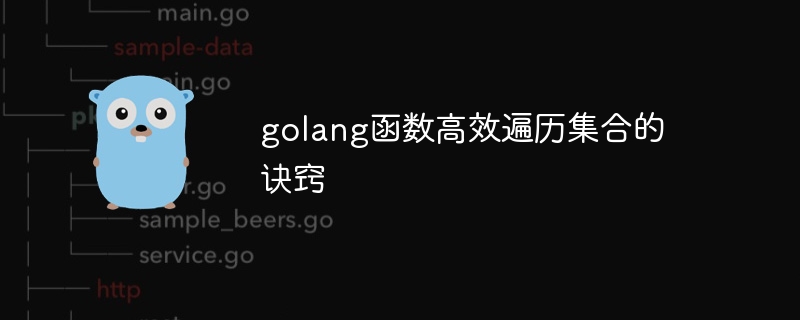Home >Backend Development >Golang >The trick to efficiently traverse collections with golang functions
The trick to efficiently traverse collections with golang functions
- PHPzOriginal
- 2024-04-25 16:51:01711browse
The trick to efficiently traverse a collection in the Go language is as follows: for-range loop: traverse a sequence, array or collection. Pointer traversal: access pointers to elements in a collection. Index traversal: Quickly access specific elements in a collection. Iterator pattern: Custom collection traversal method.

The secret of efficient traversal of collections in Go language
Traversing collections is a common task in Go language development. Optimizing traversal performance can improve the performance of the application. efficiency. This article introduces efficient traversal techniques for different types of collections and provides practical cases.
for-range loop
for-range A loop is a simple and efficient way to iterate over a sequence, array, or collection. The syntax is as follows:
for item := range iterable {
// 处理 item
}Practical case: traversing slices
slice := []int{1, 2, 3, 4, 5}
for i := range slice {
fmt.Println(i) // 输出:0 1 2 3 4
}Pointer traversal
Pointer traversal is suitable for situations where you need to access element pointers in a collection. The syntax is as follows:
for i := 0; i < len(slice); i++ {
ptr := &slice[i]
// 处理 *ptr
}Practical case: modifying slice elements
slice := []int{1, 2, 3, 4, 5}
for i := 0; i < len(slice); i++ {
ptr := &slice[i]
*ptr++ // 将元素加 1
}
fmt.Println(slice) // 输出:[2 3 4 5 6]Index traversal
Index traversal can quickly access specific elements in the collection. The syntax is as follows:
for i := 0; i < len(slice); i++ {
item := slice[i]
// 处理 item
}Practical case: Find the minimum value in a slice
slice := []int{1, 2, 3, 4, 5}
min := slice[0]
for i := 1; i < len(slice); i++ {
if slice[i] < min {
min = slice[i]
}
}
fmt.Println(min) // 输出:1Iterator mode
The iterator in the Go language is an interface. Provides standard methods for traversing collections. The syntax is as follows:
type Iterator interface {
Next() bool
Value() interface{}
}Practical case: Iterator of custom collection
type CustomSet struct {
items []int
}
func (s *CustomSet) Iterator() Iterator {
return &customSetIterator{s, 0}
}
type customSetIterator struct {
set *CustomSet
index int
}
func (i *customSetIterator) Next() bool {
if i.index >= len(i.set.items) {
return false
}
i.index++
return true
}
func (i *customSetIterator) Value() interface{} {
return i.set.items[i.index-1]
}
func main() {
set := &CustomSet{[]int{1, 2, 3, 4, 5}}
for it := set.Iterator(); it.Next(); {
fmt.Println(it.Value()) // 输出:1 2 3 4 5
}
}Conclusion
By selecting the above efficient traversal technology, you can customize the iterator according to different Collection types and traversal requirements optimize the performance of Go language applications.
The above is the detailed content of The trick to efficiently traverse collections with golang functions. For more information, please follow other related articles on the PHP Chinese website!

